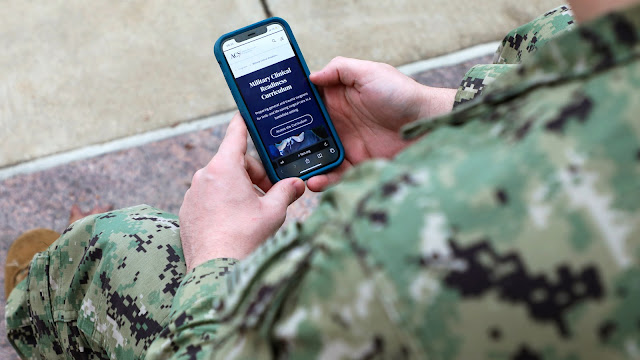New “mCurriculum” launched to help surgeons worldwide sharpen skills, improve clinical readiness
By Sarah Marshall
To ensure that surgeons worldwide, particularly military surgeons, keep their skills sharp and maintain their clinical readiness, the Uniformed Services University (USU), in conjunction with the American College of Surgeons (ACS), the Military Health System Strategic Partnership American College of Surgeons (MHSSPACS), and the University of California, Davis, has developed a new resource – the Military Clinical Readiness Curriculum, or “mCurriculum.”
The training modules are free and easily accessible, and can help surgeons around the globe to care for patients with complex injuries. They are also formatted for a smartphone, tablet, or computer and can be scanned for key points, depending on an individual’s learning needs, and they include a voiceover transcript.
The curriculum was developed with military surgeons in mind, however, the quick and easy-to-use modules are relevant to trauma patient care anywhere in the world, and can be used by any surgeon who needs to fill a particular knowledge gap. They can also be used as a “just-in-time” training resource.
How It Began
Dean of USU’s School of Medicine, Dr. Eric Elster, initially had the idea for the curriculum and this program, which came to fruition over the course of several years thanks to a long-standing collaborative relationship between the military and the ACS. In 2012, he and renowned vascular surgeon Dr. Norman Rich, former USU Department of Surgery chair, initially met with ACS’s then executive director Dr. David Hoyt to discuss ways to support a continued partnership between the ACS and the military. Through this meeting, the surgeons recognized a shared ethos as well as a need for a continued reciprocal learning relationship, which later led to the formation of the MHSSPACS.
The MHSSPACS was formalized at the Clinical Congress in 2014 for the purpose of exchanging information between the military and civilian surgical communities in four areas: trauma systems, surgical quality care, military-relevant research, and education and training. Additionally, this endeavor led to a re-establishment of the Excelsior Surgical Society for Military Surgeons, which has since become self-sustaining and has grown to include more than 450 members, Elster noted.
Then, through the MHSSPACS, military and civilian surgeons continued to foster their relationships, working together as they led a designated committee for each of the four key areas – all of which have proven to be successful, Elster said. For instance, under Trauma Systems, military and civilian surgeons wrote a blue book for military-civilian partnerships, which the military now uses to select and monitor military-civilian partnerships. Under Surgical Quality Care, a quality consortium was established, which is now used as a benchmark quality program in all military treatment facilities.
On the Education and Training front, a 2016 meeting was held with all general surgery leaders across the Military Health System, in collaboration with the ACS. This meeting laid the foundation for what became the KSA Clinical Research Program, which provides an innovative approach to measuring, evaluating, and sustaining clinical proficiency. Through this program, KSA Metrics are used to evaluate the readiness value derived from each clinician’s peacetime workload. KSA Knowledge Assessments were also developed, through this program, to ensure clinical knowledge sustainment by identifying any knowledge gaps. KSA Skills Assessments then use best-in-class educational principles to teach and assess life-, limb-, and eyesight-saving procedures. This entire effort has been adopted by the Department of Defense, Elster said, adding that it was a huge team effort involving more than 100 key personnel.
Ultimately, in developing the KSA program, it became apparent that there was also a need for a curriculum to go with the KSA Knowledge Assessment. Thus, the mCurriculum was developed, Elster explained.
What It Looks Like
The mCurriculum was developed from the KSAs, which in turn were extracted from lessons learned from the DoD’s Joint Trauma System clinical practice guidelines -- lessons learned from Operation Iraqi Freedom/Operation Enduring Freedom, Elster explained. The modules have also been translated into Ukrainian, and additional modules will be released in the near future.
The first 12 modules, available here, are broken into seven knowledge domains: airway and breathing; critical care and prevention; expeditionary unique; head and spine injury; torso trauma; transfusion and resuscitation; and wounds, amputations, and fractures. The modules include lessons such as management of war wounds, amputation, burn care, blunt abdominal trauma, wartime vascular injury, and pediatric trauma.
The program is designed to help prepare for the Knowledge Assessment, or to retrain after they take it. It can also be used for just-in-time training, should they need to sharpen their skills ahead of a unique case. Its three key components include: knowledge assessment, skills assessment, and a metric practice, which all come together to ensure that surgeons are both current and competent for that critical mission set, Elster explained.
“It’s part of our trust with the American public to ensure that our surgeons are ready for civilian trauma,” Elster said. “They’re ready for military trauma; they’re ready to take care of our nation’s heroes.”



.jpg)



